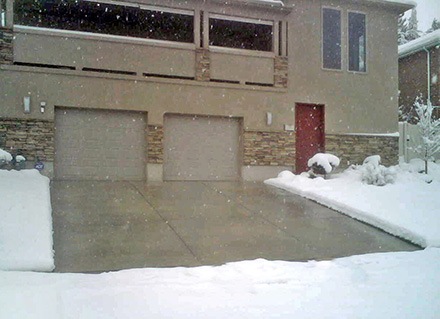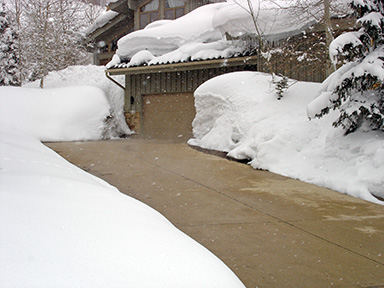Heated Driveways and Snow Melting Systems for the Sun Valley Area
The Sun Valley area gets its fair share of snow every winter. Wouldn’t it be nice to wake up to a clear driveway and sidewalks after each snowstorm? Radiant snow melting systems make this possible. Heated driveways are fully automated and energy efficient, so they only operate when needed. And because the systems have no moving parts, electric heated driveways are also maintenance free.
How Heated Driveways Work
 An advanced snow sensor (activation device) detects temperature and precipitation. When precipitation
is present and the temperature is below the adjustable set point of the sensor (usually set at
38°F or 39°F), it signals the controller, or contactor panel. (The contactor panel is typically
mounted on a wall in the garage.) Power is then sent from the contactor panel to the heat cable
embedded in the driveway, warming the surface and preventing any snow accumulation.
An advanced snow sensor (activation device) detects temperature and precipitation. When precipitation
is present and the temperature is below the adjustable set point of the sensor (usually set at
38°F or 39°F), it signals the controller, or contactor panel. (The contactor panel is typically
mounted on a wall in the garage.) Power is then sent from the contactor panel to the heat cable
embedded in the driveway, warming the surface and preventing any snow accumulation.
The Versatility of Driveway Heating Systems
Radiant snow melting systems from Warmzone have been installed in a number of applications throughout Northern America. The systems have been commonly used to heat driveways, sidewalks, loading ramps, bridges, runaway truck ramps, commercial entryways and parking areas, steps and more. These versatile systems are also easy to customize. Systems can be tailored to not only meet the specific snow melting needs, but also to accommodate the owner’s budget.
There is a variety of popular options for homeowners. For example, instead of heating the entire area of the driveway, radiant heat can be installed to heat just an 8-foot wide strip in the middle. Or two 24-inch wide tire tracks can be installed. This is a very popular and affordable option for many homeowners.
ClearZone snow melting systems are among the most popular. These proven systems feature rugged heat cable, an activation device and controller / contactor panel. The heat cable is first laid out over the area to be heated. Next, the cable is secured to the remesh with zip ties (for concrete applications). The remesh is typically supported by Mesh-Ups so that the remesh (and cable) does not rest on the ground. Next, the concrete is poured. The cable should be no more than 2 inches below the surface of the driveway.
 The snow sensor is typically installed on a post or arm extending from the roof. (It must be
exposed to the elements from all sides.) When the sensor detects precipitation and the temperature
is below 38°F, it signals the control panel, typically mounted in the garage. The controller then
sends power to the embedded heat cable to warm the driveway. These fully automated systems also
feature manual override capability, so if snow drifts form on the driveway the system may be
activated to keep the area clear.
The snow sensor is typically installed on a post or arm extending from the roof. (It must be
exposed to the elements from all sides.) When the sensor detects precipitation and the temperature
is below 38°F, it signals the control panel, typically mounted in the garage. The controller then
sends power to the embedded heat cable to warm the driveway. These fully automated systems also
feature manual override capability, so if snow drifts form on the driveway the system may be
activated to keep the area clear.
Warmzone snow melting systems are designed to ASHRAE standards. In other words, your snow melting system is designed according to uniform standards to cope with weather specific to your area. That way customers can be assured that their system will perform as intended. You see, a snow melting system in Madison, Wisconsin is not going to be the same as a system designed for Tehachapi, California. Each system is designed to deal with weather conditions in specific areas.
And Warmzone also includes free installation training, support and system design. We’re noted as the customer service leader for good reason. Call and speak with a friendly radiant heat expert and learn more about the options that are available. Call 888.488.9276 today.
